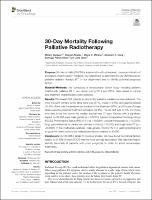| dc.contributor | Vall d'Hebron Barcelona Hospital Campus |
| dc.contributor.author | Vázquez Varela, Miriam |
| dc.contributor.author | Moreno, Diana C |
| dc.contributor.author | Geng Cahuayme, Abraham Andre Artu |
| dc.contributor.author | Pérez Hoyos, Santiago |
| dc.contributor.author | Giralt López de Sagredo, Jordi |
| dc.contributor.author | Altabas González, Manuel |
| dc.date.accessioned | 2021-12-16T07:07:47Z |
| dc.date.available | 2021-12-16T07:07:47Z |
| dc.date.issued | 2021-04-23 |
| dc.identifier.citation | Vázquez M, Altabas M, Moreno DC, Geng AA, Pérez-Hoyos S, Giralt J. 30-Day Mortality Following Palliative Radiotherapy. Front Oncol. 2021 Apr;11:668481. |
| dc.identifier.issn | 2234-943X |
| dc.identifier.uri | https://hdl.handle.net/11351/6694 |
| dc.description | Clinical indicator; Palliative radiation; Prognosis |
| dc.description.abstract | Purpose: 30-day mortality (30-DM) is a parameter with widespread use as an indicator of avoidance of harm used in medicine. Our objective is to determine the 30-DM followed by palliative radiation therapy (RT) in our department and to identify potential prognosis factors.
Material/Methods: We conducted a retrospective cohort study including patients treated with palliative RT in our center during 2018 and 2019. Data related to clinical and treatment characteristics were collected.
Results: We treated 708 patients to whom 992 palliative irradiations were delivered. The most frequent primary tumor sites were lung (31%), breast (14.8%), and gastrointestinal (14.8%). Bone was the predominant location of the treatment (56%), and the use of single doses was the preferred treatment schedule (34.4%). The 30-DM was 17.5%. For those who died in the first month the median survival was 17 days. Factors with a significant impact on 30-DM were: male gender (p < 0.0001); Eastern Cooperative Oncology Group (ECOG) Performance Status (PS) of 2–3 (p = 0.0001); visceral metastases (p = 0.0353); lung, gastrointestinal or urinary tract primary tumors (p = 0.016); and single dose RT (p = <0.0001). In the multivariate analysis, male gender, ECOG PS 2–3, gastrointestinal and lung cancer were found to be independent factors related to 30-DM.
Conclusion: Our 30-DM is similar to previous studies. We have found four clinical factors related to 30-DM of which ECOG was the most strongly associated. This data may help to identify terminally ill patients with poor prognosis in order to avoid unnecessary treatments. |
| dc.language.iso | eng |
| dc.publisher | Frontiers Media |
| dc.relation.ispartofseries | Frontiers in Oncology;11 |
| dc.rights | Attribution 4.0 International |
| dc.rights.uri | http://creativecommons.org/licenses/by/4.0/ |
| dc.source | Scientia |
| dc.subject | Càncer - Radioteràpia |
| dc.subject | Avaluació de resultats (Assistència sanitària) |
| dc.subject | Càncer - Tractament pal·liatiu |
| dc.subject.mesh | Neoplasms |
| dc.subject.mesh | /radiotherapy |
| dc.subject.mesh | Treatment Outcome |
| dc.subject.mesh | Palliative Care |
| dc.title | 30-Day Mortality Following Palliative Radiotherapy |
| dc.type | info:eu-repo/semantics/article |
| dc.identifier.doi | 10.3389/fonc.2021.668481 |
| dc.subject.decs | neoplasias |
| dc.subject.decs | /radioterapia |
| dc.subject.decs | resultado del tratamiento |
| dc.subject.decs | cuidados paliativos |
| dc.relation.publishversion | https://doi.org/10.3389/fonc.2021.668481 |
| dc.type.version | info:eu-repo/semantics/publishedVersion |
| dc.audience | Professionals |
| dc.contributor.organismes | Institut Català de la Salut |
| dc.contributor.authoraffiliation | [Vázquez M, Altabas M, Moreno DC, Geng AA, Giralt J] Servei d’Oncologia Radioteràpica, Vall d’Hebron Hospital Universitari, Barcelona, Spain. Vall d’Hebron Institute of Oncology (VHIO), Barcelona, Spain. [Pérez-Hoyos S] Unitat d'Estadística i Bioinformàtica, Vall d'Hebron Hospital Universitari, Barcelona, Spain |
| dc.identifier.pmid | 33968775 |
| dc.identifier.wos | 000648029700001 |
| dc.rights.accessrights | info:eu-repo/semantics/openAccess |

